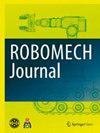平面蜗杆网状机器人WORMESH-II的侧绕运动
IF 1.7
Q3 INSTRUMENTS & INSTRUMENTATION
引用次数: 0
摘要
WORMESH-II, which is the second prototype in the WORMESH series, is inspired by a flatten and soft-bodied fatworm, and its uniqueness is the use of multiple travelling waves for locomotion. In this paper, the sidewinding locomotions for WORMESH-II are talked about. This is because sidewinding is one of the most effective ways to traverse sandy terrain. The mathematical model of the sidewinding locomotion kinematics of WORMESH-II explains how synchronous multiple sidewinding waves can be used to control the movement of the robot effectively. Unlike WORMESH’s pedal-wave locomotion, sidewinding gaits allow the robot to be manoeuvred in any direction without changing the joint sequence. Relative to the wave propagation direction, velocity in the longitudinal direction is dependent on the vertical component of sidewinding travelling waves. Moreover, velocity in the transverse direction depends on the horizontal component of sidewinding travelling waves. The velocity in the longitudinal direction becomes zero when the phase shift of the travelling waves equals $$\pi $$ rad. The angular velocity around the instantaneous centre of rotation depends on the wave amplitude of the horizontal component of the sidewinding travelling wave along the kinematic chains, and the turning radius is proportional to the amplitude gradient along the kinematic chains. The dynamic simulation of WORMESH-II and testing with the WORMESH-II prototype confirmed the proposed method, which was based on the metamathematical explanation of locomotion.本文章由计算机程序翻译,如有差异,请以英文原文为准。
Sidewinding locomotion of flatworm-like mesh robot WORMESH-II
WORMESH-II, which is the second prototype in the WORMESH series, is inspired by a flatten and soft-bodied fatworm, and its uniqueness is the use of multiple travelling waves for locomotion. In this paper, the sidewinding locomotions for WORMESH-II are talked about. This is because sidewinding is one of the most effective ways to traverse sandy terrain. The mathematical model of the sidewinding locomotion kinematics of WORMESH-II explains how synchronous multiple sidewinding waves can be used to control the movement of the robot effectively. Unlike WORMESH’s pedal-wave locomotion, sidewinding gaits allow the robot to be manoeuvred in any direction without changing the joint sequence. Relative to the wave propagation direction, velocity in the longitudinal direction is dependent on the vertical component of sidewinding travelling waves. Moreover, velocity in the transverse direction depends on the horizontal component of sidewinding travelling waves. The velocity in the longitudinal direction becomes zero when the phase shift of the travelling waves equals $$\pi $$ rad. The angular velocity around the instantaneous centre of rotation depends on the wave amplitude of the horizontal component of the sidewinding travelling wave along the kinematic chains, and the turning radius is proportional to the amplitude gradient along the kinematic chains. The dynamic simulation of WORMESH-II and testing with the WORMESH-II prototype confirmed the proposed method, which was based on the metamathematical explanation of locomotion.
求助全文
通过发布文献求助,成功后即可免费获取论文全文。
去求助
来源期刊

ROBOMECH Journal
Mathematics-Control and Optimization
CiteScore
3.20
自引率
7.10%
发文量
21
审稿时长
13 weeks
期刊介绍:
ROBOMECH Journal focuses on advanced technologies and practical applications in the field of Robotics and Mechatronics. This field is driven by the steadily growing research, development and consumer demand for robots and systems. Advanced robots have been working in medical and hazardous environments, such as space and the deep sea as well as in the manufacturing environment. The scope of the journal includes but is not limited to: 1. Modeling and design 2. System integration 3. Actuators and sensors 4. Intelligent control 5. Artificial intelligence 6. Machine learning 7. Robotics 8. Manufacturing 9. Motion control 10. Vibration and noise control 11. Micro/nano devices and optoelectronics systems 12. Automotive systems 13. Applications for extreme and/or hazardous environments 14. Other applications
 求助内容:
求助内容: 应助结果提醒方式:
应助结果提醒方式:


